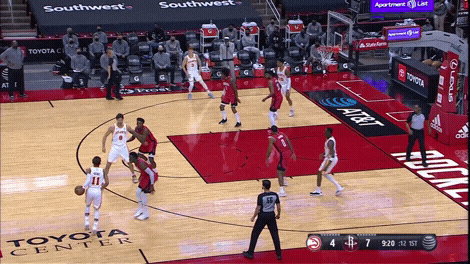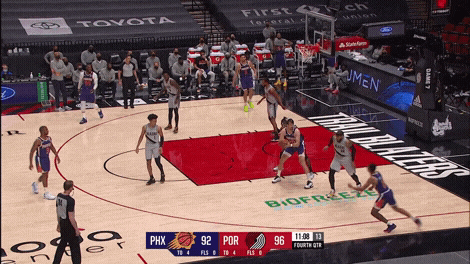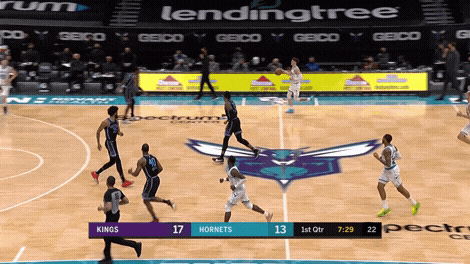
Trae Young and the Hawks have won six straight games.
Each week during the season, NBA.com writer John Schuhmann surveys the league to compile stats and notes for his in-depth Power Rankings. Before the next rankings drop on Monday, here are some of the storylines he’s keeping an eye on this weekend.
1. The Hawks’ difference maker
Though they added playmaking and shooting in the offseason, the Atlanta Hawks’ offense still falls off a cliff when Trae Young goes to the bench. The Hawks have scored 13.7 more points per 100 possessions with Young on the floor (116.2) than they have with him off the floor (102.5). That differential is down from last season (15.5), but is still the fourth biggest on-off OffRtg differential among players who’ve played at least 500 minutes.
The top 10 has a lot of the players you’d expect … and Kelly Olynyk.
Biggest on-off differential, team’s points scored per 100 possessions
| Player | MIN | On | Off | Diff. | eFG% |
|---|---|---|---|---|---|
| Nikola Jokic | 1,428 | 119.7 | 104.0 | 15.7 | 60.5% |
| Luka Doncic | 1,278 | 116.7 | 102.0 | 14.7 | 54.3% |
| Stephen Curry | 1,316 | 112.5 | 98.7 | 13.8 | 59.1% |
| Trae Young | 1,310 | 116.2 | 102.5 | 13.7 | 50.0% |
| Damian Lillard | 1,374 | 119.0 | 105.4 | 13.6 | 55.6% |
| Jamal Murray | 1,337 | 119.0 | 105.4 | 13.6 | 55.5% |
| Joel Embiid | 1,010 | 117.9 | 104.6 | 13.3 | 55.9% |
| Zach LaVine | 1,381 | 113.6 | 100.7 | 12.9 | 62.3% |
| Bradley Beal | 1,284 | 111.8 | 99.4 | 12.4 | 53.3% |
| Kelly Olynyk | 1,082 | 111.8 | 99.8 | 12.0 | 55.9% |
eFG% = Player’s effective field goal percentage.
Minimum 500 minutes on the floor.
Young is thought of as a shooter, but he’s been the least effective shooter of that group. His effective field goal percentage* of 50.0% is well below the league average (53.8%) and ranks 106th among 136 players with at least 300 field goal attempts. Young has shot below the league average in the restricted area, on other shots in the paint, and from mid-range. His 3-point percentage (37.5%) is above average (36.7%), but ranks just 48th among 87 players who’ve attempted at least five 3-pointers per game. And because only 60% of his shots have come from the restricted area or 3-point range (the league average is 70%), he’s not maximizing his percentages.
* Effective field goal percentage = (FGM + (0.5 * 3PM)) / FGA
So how is Young such a difference maker on offense?
First of all, he gets to and shoots well from the free throw line. Young’s 9.5 free throw attempts per game rank third and his 87.3% ranks eighth among 37 players who’ve averaged at least five attempts per game.
On his first offensive possession after returning to the game in the second quarter on Tuesday, Young turned the corner on Jae’Sean Tate and then, instead of taking off with one foot, hit the breaks to draw a foul under the basket…

With free throws, Young is above the league average in regard to scoring efficiency. While his effective field goal percentage ranks 106th among those 136 players with at least 300 field goal attempts, Young’s true shooting percentage* of 59.4% ranks 51st.
* True shooting percentage = PTS / (2 * (FGA + (0.44 * FTA)))
And what really makes Young so important to the Hawks’ offense is his passing. Young ranks third in the league at 9.4 assists per game. He’s second in total assists in the restricted area (181) and seventh in assists on 3-pointers (308).
Most of those assists come out of the pick-and-roll. According to Second Spectrum tracking, Young has used 1,982 ball screens, most in the league. That’s 52.2 per game or 1.5 ball screens for every minute that he’s been on the floor.
And with all the reads that Young can make out of the pick-and-roll, you can understand the high volume.
Young has 98 assists to John Collins and 79 assists to Clint Capela. Those are the second and third most assists from one player to a single teammate, topped only by Draymond Green’s 108 assists to Stephen Curry. And in Capela and Collins, Young has two lob threats who can take advantage of the attention that their defender puts on Young in a pick-and-roll, even if no actual screen is set.
According to Second Spectrum, there’s been contact on less than half (47%) of the ball screens that the Hawks have set for Young. That rate is 57% for Luka Doncic and 59% for Damian Lillard, by comparison. Late in the second quarter on Tuesday, Collins slipped out of a screen for Young and got behind his defender for a lob …

Young is about as good a lob passer as there is in the league. Here’s one for Capela off a staggered screen (with contact), where Robin Lopez came out just far enough for Young to squeeze the pass between him and the non-committal weak-side tag from Russell Westbrook …

If that weak-side defender takes away the lob, Young can kick out to the weak-side shooter …

Or just wait things out and find another angle …

Turnovers can be an issue. Young has the seventh highest turnover rate (12.3 per 100 possessions) among the 48 players with a usage rate of 25% or higher. Against a switching defense, he can get stuck …

But if he can gain an advantage somewhere, Young has the patience and vision to find what’s open …

The Hawks will go for their seventh straight win in a matchup against the Oklahoma City Thunder tonight (7:30 ET, NBA League Pass).
2. The value of a timely dive
On that game-winner against the Raptors last week, Young obviously got credit for the assist and Tony Snell, shooting an amazing 41-for-70 (59%) on catch-and-shoot 3s, got credit for making the shot, but Kevin Huerter also deserves acknowledgment for helping Snell get open.
When Young turns the corner on Stanley Johnson, Kyle Lowry comes from the weak side (he was guarding Snell in the right corner) to help in the paint. That left Norman Powell guarding Snell and Huerter on the weak side …

If both Snell and Huerter remain stationary, Powell can close out to either one. But Huerter sees Lowry’s help and dives to the rim. That draws Powell into the paint and leaves Snell all alone on the right side of the floor.
A weak-side dive behind (or in front of) a ball-watching defender can often turn into a highlight …

It can also be an “assist” of sorts, drawing a weak-side defender into the paint to free up a teammate beyond the arc. On the same night of Snell’s game-winner, the Suns got two open 3-pointers as a result of timely weak-side dives. First, a Mikal Bridges dive behind Nasir Little drew help from Damian Lillard and freed up Jae Crowder …

Later, a Cameron Payne dive drew the attention of Rodney Hood and opened up a kick-out to Abdel Nader …

We probably don’t need to track “dive assists” like we do “screen assists,” but the sacrificial dive man should be acknowledged.
3. Gordon Hayward plays big
LaMelo Ball gets the headlines and Terry Rozier (now 10-for-18 on clutch 3s) hits the big shots, but a big reason why the Charlotte Hornets have seen the league’s fifth biggest jump in offensive efficiency (they’ve scored 5.3 more points per 100 possessions than they did last season) is the addition of Gordon Hayward, who is averaging a team-high (and efficient) 20.7 points per game.
The Hornets like to run; They rank second in the percentage of their possessions that have been in transition (19.4%) and sixth in points per transition possession (1.16). Hayward had his own fast-break highlight on Monday, dunking on De’Aaron Fox amid Charlotte’s comeback from seven points down with 4 1/2 minutes to go.
But a staple of the Hornets’ half-court offense is getting Hayward matched up with opposing guards. And we saw a lot of that in that win over Sacramento, with Hayward setting ball screens that the Kings switched, and then taking the guard into the post.
Midway through the first quarter, Hayward set a “pistol” screen along the right sideline for Ball. Buddy Hield switched the screen and Hayward didn’t let Fox get on the other side of him. With a perfect high-low pass from Cody Zeller (and a goaltending violation from Richaun Holmes), Hayward had a bucket …

A few minutes later, Hayward set the same screen for Devonte’ Graham, put Tyrese Haliburton on his back, and drew a foul (prior to the layup) …

And later in the first quarter, Hayward set a “horns” screen for Graham, took Cory Joseph into the paint, and got an easy bucket …

Midway through the third quarter, Hayward had Fox on him via another switch. But Holmes saw what was happening, drifted off of Bismack Biyombo and “scrammed” Fox, switching onto Hayward. Harrison Barnes slid down to take Biyombo, and Fox picked up Miles Bridges …

The result was Rozier isolating against Hield and missing a contested shot in the paint.
Hayward got another bucket against a Kings guard late in the fourth quarter. Matched up with Haliburton after a miss on the other end of the floor, he didn’t need to set a screen. He just ducked in, nudged the rookie out of bounds, and had himself a layup …

Hayward is only 6-foot-7, but he’s strong and comfortable with his back to the basket. According to Second Spectrum tracking, he set the same number of ball screens last season with Boston (4.7 per game) as he has with Charlotte. But when he was screening for Kemba Walker, that was mostly to free up the point guard. A lot of those screens were part of “double-drag” actions meant for Walker to attack opposing bigs.
With the Hornets, Hayward has more often set screens to get himself a bucket, in the mold of Dirk Nowitzki (ball-screen, take the guard to the nail, go to work). He has only 23 post-up possessions according to Synergy tracking, but that’s up from 15 last season and the 1.35 points per possession Hayward has scored on post-ups ranks first among 79 players with at least 20 post-up possessions.
The Hornets are most fun when they’re getting up and down the floor. But Hayward is their best weapon for the more deliberate half-court offense that they need down the stretch of close games and in the playoffs.
As they land in Los Angeles for a game against the Lakers on Thursday (10:30 p.m. ET, NBA TV) and another against the Clippers on Saturday (10 p.m. ET, League Pass), the Hornets are in fifth place in the Eastern Conference. But their loss in Denver on Wednesday began a stretch where they’re playing seven of nine against teams that currently have winning records.
The Eastern Conference still has just five teams over .500, but it has a 53-35 record against the West over the last 30 days, with the sixth, seventh and eighth spots looking stronger than they did a month ago. That race to finish fifth or sixth (to avoid the Play-In Tournament) or seventh or eighth (to avoid the need to win two Play-In games to reach the playoffs) will be fun to watch.
4. No. 1 for a reason
Anthony Davis has now missed the last 12 games for the Lakers. And while offense has been a struggle, the Lakers’ defense has remained strong without its best defensive player. L.A. ranks sixth defensively (108.0 points allowed per 100 possessions) over the time that Davis has been out, and remains comfortably in the top spot for the season (106.0). A couple of possessions from the first quarter of the Lakers’ win over the Warriors on Monday can show you why.
On both occasions, Montrezl Harrell addresses the Stephen Curry threat by blitzing a handoff. On the first play, Wesley Matthews tags James Wiseman’s roll and then recovers out to his man (Andrew Wiggins). Then Talen Horton-Tucker slides down to cover Wiseman until Harrell recovers. Horton-Tucker then recovers to his man (Kent Bazemore) with a controlled close-out and Bazemore misses from the corner after hesitating …

On the second play, Matthews again tags the Wiseman roll. But when Curry throws a skip pass to Wiggins in the left corner, Kyle Kuzma rotates down. Dennis Schroder then leaves Curry (a risk, for sure) to rotate to Draymond Green. Horton-Tucker helps on Green’s drive and then contests another Bazemore 3-pointer with another controlled close-out. The ensuing airball led to a Lakers’ break …

That’s five defenders working hard and on a string.
* * *
John Schuhmann is a senior stats analyst for NBA.com. You can e-mail him here, find his archive here and follow him on Twitter.
The views on this page do not necessarily reflect the views of the NBA, its clubs or Turner Broadcasting.










